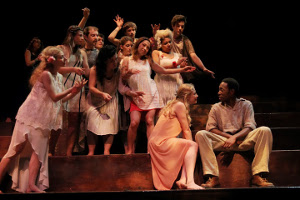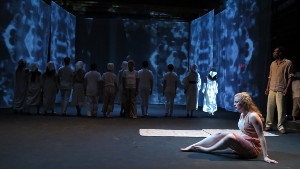|
|
 |
| The whole forest watches eagerly as Sylph and a young human fall in love. Photo by Volodymyr Klyuzko. |
The show is offering $15 admission for audience members who will arrive early and learn a song to participate in the show. Why not have the whole experience? Screwing up my courage, I arrived at La MaMa half-an-hour early in order to learn two Ukrainian folk songs that would be featured in the performance. It was an intrepid commitment for me, a college-aged non-actor whose experience with alterative theater was, shall we say, only introductory: limited to theater peformances in my home town of Washington, D.C. and at school in Massachusetts. I was not entirely sure what to expect, and I was even a little bit scared that I would be forced to come on stage when these particular numbers came up in the play. Perhaps luckily, this did not come to pass.
With only two other participants and a tardy composer with limited English-language skills who would be teaching us the song, we only had a grand total of five minutes of learning before we had to return to the lobby to await the start of the performance. Though the words remained incomprehensible in that time, and I definitely could not recite those tunes now if you asked me to, it was nice to hear something at least a little bit familiar later in the evening--when everything else was entirely new to me.
One of the most central elements of “Fire. Water. Night” was the movement of the audience. There was no one stage, and no one area where the audience was expected to sit and watch. The performance began rather suddenly, as the lights suddenly turned off as we milled about in the lobby of the Ellen Stewart Theatre. Several performers perforated the audience, walking in slow, calculated steps while singing a somber, high-pitched song. With dark lights, icy tones, and white flashes both in costume and lighting, the feeling of winter was inescapable. This introduction, which later featured the drowning of a young peasant man for the apparent pleasure of a water nymph, set the dark tone of what was to come.
Finding myself in yet another unconventional position, the second portion of the performance took place inside the theater, but with the audience sitting below the players, on the stage, while the performers acted on the bleachers usually reserved for spectators. The action did not present itself through conventional conversation, but rather imitated the voices of the forest as the characters, each representing an element of the forest such as a birch or a berry tree, responded to one another through either repetition (both in English and Ukrainian) or movement. Based on the season of spring, this segment began with a rather literal interpretation as all of the actors slowly “thawed” and “bloomed,” unraveling from compressed and contorted positions slowly and carefully. Though the plot was hard to follow due to the unconventional dialogue and movement, it was at this point that they introduced a love story between a forest-nymph and a young human man.
The next portion of the performance was overwhelming. For reasons that were unclear, we were moved once again into the lobby, for something that felt more like a foreign wedding than a play. Folk music was sung loudly by all the players, accompanied by the joyous fiddling of Lemon Bucket Orkestra of Toronto, all while dancing frenetically in circles. This is when the songs I had learned came into the performance. I needn't have worried about being onstage; it all happend among a swirl of people in the lobby.
 |
| In a rare portion of the performance where the audience sat watching the actors as they were on stage, the Sylph sits in despair as industrial clones seems to invade her beloved natural world. |
Audience members were constantly dragged into the dancing, many with great reluctance. I myself was taken in twice, much to my initial dismay. This portion functioned as a simultaneous intermission, dance party, and performance, and delicious homemade drinks were served.
In the final stage of the performance, the audience moved back into the theater, with the positions reversed as we sat in the bleachers while the performance took place on stage. As we returned, the cast guided us to our seats, referring to us as vegetables all the while. The nymph and the man seemed to have gotten married by this point, yet unforeseen strains took hold. The nymph was reviled by her mother-in-law and reluctant to do any farm work that would kill her plant-friends; this romance did not seem to work out. The final portion of the performance also featured great deal of historical film footage of female farm laborers that was projected onto a screen in the background.
Ultimately, my first time at La MaMa was pleasant. I may have been lost some of the time, and there may have been more participation than I was used to, but I was exhilirated by the effort that went into this raw performance.
IF YOU GO
June 7 to June 16, 2013
La MaMa's Ellen Stewart Theatre
66 East 4th St, New York City
Performance by the Yara Arts Group
Thurs-Sat 7:30 PM, Sun 2:30 PM
Tickets $25; Box office: 212-475-7710 or www.lamama.org
$15 discount tickets for participants who come early and learn
a song - to sign up email yara@prodigy.net
William Gutierrez is the Arts Editor of the
Williams Record, the independent student newspaper of Williams
College.
| lobby | search
| home |
cue-to-cue | discounts |
welcome | film
| dance | reviews
|
| museums |
NYTW mail | recordings |
coupons | publications |
classified |

